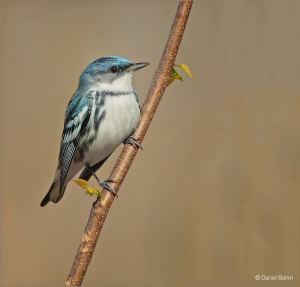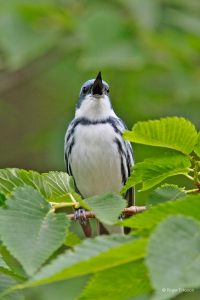 The Cerulean Warbler is a small bird of the deciduous forest treetops, the sky-blue Cerulean Warbler can be difficult to see. Cerulean Warbler is one of the species of highest concern in the eastern United States because of a small total population size and significant declines throughout its range. The North American Breeding Bird Survey estimates a decline of over 2.6% per year between 1966 and 2015, resulting in a cumulative loss of 74% of the population in that time. Partners in Flight estimates a global breeding population of 600,000, with 98% breeding in the U.S., and 2% in Canada. It is a Tri-National Concern Species and a U.S.-Canada Stewardship species and rates a 15 out of 20 on the Continental Concern Score. Cerulean Warbler is on the 2016 State of North America’s Birds’ Watch List, which includes bird species that are most at risk of extinction without significant conservation actions to reverse declines and reduce threats. It is listed as Vulnerable on the IUCN Red List.
The Cerulean Warbler is a small bird of the deciduous forest treetops, the sky-blue Cerulean Warbler can be difficult to see. Cerulean Warbler is one of the species of highest concern in the eastern United States because of a small total population size and significant declines throughout its range. The North American Breeding Bird Survey estimates a decline of over 2.6% per year between 1966 and 2015, resulting in a cumulative loss of 74% of the population in that time. Partners in Flight estimates a global breeding population of 600,000, with 98% breeding in the U.S., and 2% in Canada. It is a Tri-National Concern Species and a U.S.-Canada Stewardship species and rates a 15 out of 20 on the Continental Concern Score. Cerulean Warbler is on the 2016 State of North America’s Birds’ Watch List, which includes bird species that are most at risk of extinction without significant conservation actions to reverse declines and reduce threats. It is listed as Vulnerable on the IUCN Red List.
 By 2080, this already declining Neotropical migrant is projected to have 98 percent of its current summer range shifted away from the current core, but it has potential to expand in the north, according to Audubon’s climate model. Mature hardwood forests that the bird depends on may not exist to the north and the forests expansion may not keep pace with the changing climate.
By 2080, this already declining Neotropical migrant is projected to have 98 percent of its current summer range shifted away from the current core, but it has potential to expand in the north, according to Audubon’s climate model. Mature hardwood forests that the bird depends on may not exist to the north and the forests expansion may not keep pace with the changing climate.
It nests and forages higher in the canopy than most other warblers. They breed in forests with tall deciduous trees and open understories, such as wet bottomlands and dry slopes. The Cerulean Warbler winters in broad-leaved, evergreen forests.
On the wintering grounds in South America, the Cerulean Warbler usually is found in mixed-species foraging flocks, associating with tropical tanagers and other resident species. When renesting after a failed first nest, the female often uses spider web from the old nest to start construction on the new nest. Fresh lining is gathered for the new nest, but spider web may be too valuable and time-consuming to waste. The female Cerulean Warbler has an unusual way of leaving a nest after sitting on it a while. Some people call it “bungee-jumping.” She drops from the side of the nest, keeping her wings folded to her sides, and opens her wings to fly only when she is well below the nest.
